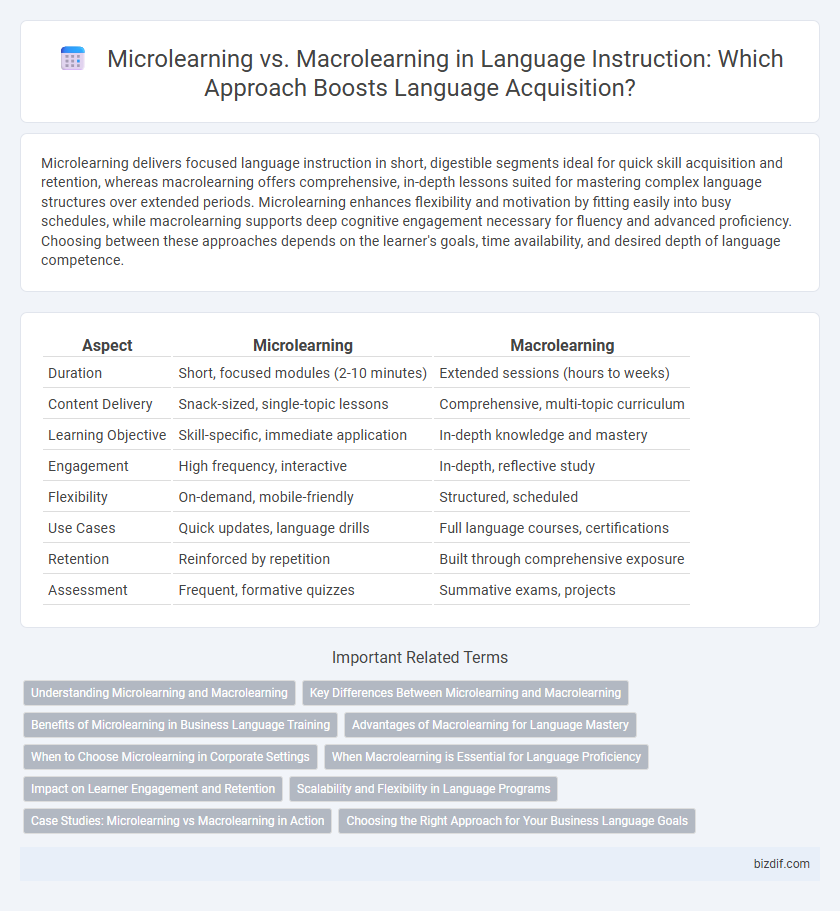Microlearning delivers focused language instruction in short, digestible segments ideal for quick skill acquisition and retention, whereas macrolearning offers comprehensive, in-depth lessons suited for mastering complex language structures over extended periods. Microlearning enhances flexibility and motivation by fitting easily into busy schedules, while macrolearning supports deep cognitive engagement necessary for fluency and advanced proficiency. Choosing between these approaches depends on the learner's goals, time availability, and desired depth of language competence.
Table of Comparison
| Aspect | Microlearning | Macrolearning |
|---|---|---|
| Duration | Short, focused modules (2-10 minutes) | Extended sessions (hours to weeks) |
| Content Delivery | Snack-sized, single-topic lessons | Comprehensive, multi-topic curriculum |
| Learning Objective | Skill-specific, immediate application | In-depth knowledge and mastery |
| Engagement | High frequency, interactive | In-depth, reflective study |
| Flexibility | On-demand, mobile-friendly | Structured, scheduled |
| Use Cases | Quick updates, language drills | Full language courses, certifications |
| Retention | Reinforced by repetition | Built through comprehensive exposure |
| Assessment | Frequent, formative quizzes | Summative exams, projects |
Understanding Microlearning and Macrolearning
Microlearning delivers focused, bite-sized lessons that enhance retention and fit into busy schedules, making it ideal for skill reinforcement and quick knowledge updates. Macrolearning involves comprehensive, in-depth modules designed for mastery of complex subjects through extended engagement and structured coursework. Effective language instruction balances microlearning's concise, repetitive practice with macrolearning's broader contextual understanding to optimize fluency and long-term proficiency.
Key Differences Between Microlearning and Macrolearning
Microlearning delivers concise, focused content often lasting under 10 minutes, ideal for quick skill acquisition and knowledge retention. Macrolearning encompasses comprehensive, in-depth instruction that spans significant timeframes, supporting mastery and complex understanding. Key differences lie in duration, content depth, learner engagement methods, and application contexts, with microlearning emphasizing brevity and flexibility while macrolearning prioritizes thoroughness and extended learning outcomes.
Benefits of Microlearning in Business Language Training
Microlearning enhances business language training by delivering content in concise, targeted segments that improve retention and engagement. Employees can acquire language skills quickly during short breaks, leading to increased productivity without disrupting work schedules. This method also allows for personalized learning paths, addressing specific communication challenges relevant to various business contexts.
Advantages of Macrolearning for Language Mastery
Macrolearning offers comprehensive language instruction that allows for deep contextual understanding and sustained practice, essential for achieving advanced proficiency. Extended learning sessions in macrolearning facilitate the integration of complex grammar rules, vocabulary, and cultural nuances, resulting in long-term retention. This holistic approach supports fluency development by enabling learners to engage with authentic language materials and real-world communication scenarios.
When to Choose Microlearning in Corporate Settings
Microlearning is ideal for corporate settings requiring quick skill updates or reinforcing specific knowledge without overwhelming employees. It enhances retention and engagement by delivering focused, bite-sized content suited for time-constrained work environments. Choose microlearning when addressing just-in-time training, compliance refreshers, or onboarding modules that benefit from flexibility and immediate application.
When Macrolearning is Essential for Language Proficiency
Macrolearning is essential for achieving advanced language proficiency because it provides comprehensive and in-depth exposure to complex grammatical structures, vocabulary, and cultural nuances that microlearning's brief sessions often cannot cover. Extended studies through macrolearning enable sustained practice and immersive experiences necessary for mastering language fluency and nuanced communication. This approach supports long-term retention and the ability to engage in sophisticated conversations, critical for professional and academic language use.
Impact on Learner Engagement and Retention
Microlearning enhances learner engagement by delivering concise, focused content that fits easily into busy schedules, boosting retention through repetitive reinforcement of key concepts. Macrolearning provides comprehensive understanding and deeper context, promoting critical thinking and long-term knowledge application. Balancing microlearning's immediate engagement with macrolearning's depth ensures optimal retention and learner motivation in language instruction.
Scalability and Flexibility in Language Programs
Microlearning offers unmatched scalability and flexibility in language programs by delivering bite-sized, targeted lessons that cater to individual learner paces and schedules. Macrolearning structures provide comprehensive, in-depth language acquisition but often lack adaptability to diverse learner needs and slower scalability across large groups. Emphasizing microlearning enables language instruction platforms to efficiently scale content delivery while maintaining personalized flexibility for varied proficiency levels and learning environments.
Case Studies: Microlearning vs Macrolearning in Action
Case studies reveal microlearning's effectiveness in improving retention rates by 20%, making it ideal for just-in-time training and skill reinforcement. Macrolearning excels in comprehensive curriculum development, supporting deep understanding and long-term knowledge acquisition across complex subjects. Organizations that blend microlearning modules with macrolearning frameworks report enhanced learner engagement and measurable performance improvements.
Choosing the Right Approach for Your Business Language Goals
Microlearning delivers content in focused, bite-sized modules that enhance retention and allow flexible integration into busy schedules, making it ideal for quick skill acquisition in business language training. Macrolearning provides comprehensive, in-depth courses designed to build advanced language proficiency over time, beneficial for long-term development and complex communication skills. Selecting the right approach depends on your business goals, employee learning preferences, and the desired pace of language acquisition to ensure effective and efficient language instruction.
Microlearning vs macrolearning Infographic

 bizdif.com
bizdif.com